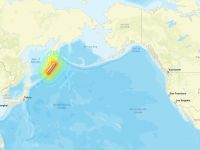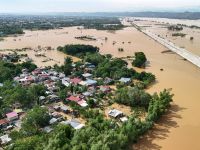The "Intelligence Community Assessment of the Lieutenant Commander Speicher Case" is a summary of all the facts known about the case to the American intelligence agencies. It was produced at the request of the U.S. Senate "Select Committee on Intelligence" in March, 2001.
Introduction
An F/A-18 Hornet, piloted by LCDR Michael Scott Speicher, was brought down over west-central Iraq during a mission on 17 January 1991-the only aircraft downed that first night of the air war. LCDR Speicher was the only US serviceman lost over land during Operation Desert Storm whose status remained Killed in Action-Body Not Recovered (KIA-BNR). (1) The Senate Select Committee on Intelligence has asked the Intelligence Community (IC) to assess the Speicher case and also to provide an unclassified version of the assessment.
We assess that Iraq can account for LCDR Speicher but that Baghdad is concealing information about his fate. LCDR Speicher probably survived the loss of his aircraft, and if he survived, he almost certainly was captured by the Iraqis.
Night of the Shootdown
During Desert Storm, none of the limited information available on coalition personnel lost was linked to the fate of LCDR Speicher. No information during the Gulf war conclusively revealed how LCDR Speicher's aircraft was destroyed. Postwar analysis suggests that LCDR Speicher's Hornet was downed by an Iraqi Air Force aircraft firing an air-to-air missile. LCDR Speicher's aircraft crashed in the desert west of Baghdad.
During the shootdown of LCDR Speicher's aircraft, no parachute was seen - it was nighttime-and neither combat search-and-rescue resources nor intelligence revealed any indication that LCDR Speicher tried to signal by radio, beacon, or other means. We judge that this information is inconclusive with regard to the fate of LCDR Speicher; the lack of observed parachutes and radio calls or other signals are not definitive indicators of a pilot's fate.
Iraqi Repatriations ... No-Accounting for LCDR Speicher
Shortly after the Desert Storm cease-fire, Iraq began repatriating captured Coalition personnel. With the exception of LCDR Speicher (and a Saudi Arabian pilot), all other Coalition airmen downed over land during the war with Iraq were accounted for. Baghdad either released the airmen or returned remains that were later positively identified. (2) We judge that the regime was aware of Western press reports during the war that indicated LCDR Speicher was dead. Therefore, Baghdad probably did not feel compelled to accurately account for LCDR Speicher. The absence of contacts between LCDR Speicher and US forces after his ejection or with other Coalition prisoners of war (POWs) is an inconclusive indicator of LCDR Speicher's fate.
False Remains
In March 1991, Iraq returned a small amount of human remains and identified the remains as a pilot named "Mickel." Laboratory results revealed the remains were human, but not those of LCDR Speicher. Saddam's regime probably hoped the unidentified remains would satisfy Washington. Baghdad has since claimed that LCDR Speicher was devoured by animals and that no remains were found.
Crash Site Survey and Excavation
In December 1993, a US F/A-18 crash site in Southwestern Iraq was located and US authorities were notified. The wreckage was confirmed to be that of LCDR Speicher's aircraft. The site was located on imagery in April 1994, using US U-2 imagery taken in 1991. On 14 February 1995, the ICRC, at the request of the USG, contacted Iraq about the US plan to excavate an F/A-18 crash site in Iraq. Baghdad delayed the matter until late October 1995 when Iraqi permission for the team's entry was obtained.
The team was in Iraq from 9-16 December. The investigators passed the approximate location of the crash site to their Iraqi contacts on the night of 9 December. The ICRC team traveled to the location the next morning. The ICRC team found evidence that the site had been expertly searched within one month prior to the team's arrival: the Iraqis excavated the cockpit area of the wreckage and removed all significant cockpit debris. A US Navy F/A-18 aircraft mishap investigator who participated in the 1995 ICRC excavation also believed the wreckage was likely examined in the month preceding the survey but that major portions of the cockpit and instrument bay section were removed years prior to the ICRC team's arrival.
Analysis of the wreckage by US Navy experts concluded that LCDR Speicher initiated the ejection sequence, jettisoned the canopy, and likely ejected from the stricken aircraft prior to the crash. The canopy was located near the crash site; the ejection seat could not be found. Investigators were able to examine other parts of the aircraft including large portions of the wings and the fuselage behind the cockpit, the canopy frame, the engines, and wing pylons. In addition, the team recovered a data storage unit and fragments of life support equipment, as well as a flight suit handed over by the Iraqis. (see below)
US Navy analysis of the F/A-18 wreckage resulting from the 1995 crash-site excavation showed the forward part of LCDR Speicher's aircraft suffered a catastrophic event in the early morning hours of 17 January 1991. At the time of the first impact LCDR Speicher's F/A-18 was at 28,000 feet and traveling at .92 Mach (540 kts). The Hornet suffered a power loss, prior to the canopy being jettisoned. Evidence indicates the impact threw the aircraft laterally off its flight path at least 50 to 60 degrees, subjecting the aircraft to a minimum 6-G load.(3)
US Navy investigators concluded that the pilot was not incapacitated by the initial incident. Flight surgeons and aircraft life support systems experts believe LCDR Speicher would have had at least 85 to 90 percent chance of surviving (with second-degree burns to exposed skin) the resultant flash heat and fire and aerodynamic forces of the initial impact that brought down his aircraft. According to several Gulf war veterans and US military aircrew, LCDR Speicher was probably well protected from the flash fire by his flight gear.
During the December 1995 survey, the Iraqis directed ICRC team members to the flight suit which was purportedly "found" by a Bedouin boy, but the official Casualty Identification Laboratory Hawaii (CILHI) examination of the suit concluded it showed minimal weathering and adherent soil. We believe the Iraqis planted the flight suit. Near the site where the Iraqis claimed the uniform was "discovered," a few samples of other pilot-related materials were found. Some or all of these items may not have originated in the area in which they were recovered, according to the investigation's results. (4) US Navy experts assessed that the flight suit was the right type and the same size as the suit worn by LCDR Speicher. They also determined that the location and shape of the velcro used to affix patches was correct for LCDR Speicher and his unit. The condition of the returned flight suit also indicates that the aviator was not in the aircraft at ground impact. Specialists determined that damage to the recovered flight suit indicates exposure to a few seconds of heat. Also, the flight suit showed only a trace of possible blood. We can only speculate as.to why the Iraqis chose to return the flight suit. They may have calculated that they had to produce some evidence related to the pilot in order to appear cooperative and put an end to further inquiries. They could have altered the evidence to mislead investigators.
According to US Navy data, noncombat F/A-18 ejection statistics reveal that 90 percent of pilots survive. This same data shows that of the pilots who ejected over land and survived, 70 percent were injured in some way. Navy experts assessed that LCDR Speicher probably was injured during the ejection and parachute landing. These injuries could have resulted from parachute opening shock and from his parachute landing. A review of postwar reporting from downed aircrew indicates some were seriously injured by their ejection and parachute landing, while others suffered relatively minor injuries or survived unscathed. (5) The Iraqis could have cut-off the suit because they did not know how to properly release the various fasteners or were perhaps trying to intimidate their captive. The cuts also could indicate the pilot was injured, unconscious or deceased when the uniform was removed. Alternatively, the Iraqi regime may have altered the flight suit (for example, by cutting) to deceive foreign investigators.
We do not know if LCDR Speicher survived the ejection sequence or subsequent landing, but the lack of crash-site evidence of LCDR Speicher's death, US Navy statistical data associated with F/A 18 incidents, and the condition of the returned flight suit suggest that he probably survived the crash of his F/A-18.
Conclusion
The way Baghdad has handled the case-falsely suggesting that remains returned in 1991 were those of LCDR Speicher, tampering with the F/A-18 wreckage before the 1995 crash site excavation, planting the flight suit for crash investigators to find, and declining to account accurately for LCDR Speicher¡raises troubling questions about his fate
The regime made it a high priority to capture enemy personnel or recover remains inside Iraqi-controlled territory, and Baghdad would have thoroughly investigated the matter until the pilot was captured or the remains recovered. Baghdad's efforts to recover Coalition airmen downed over Iraqi-controlled territory were highly successful.
We judge that Baghdad was aware of January 1991 western press reports that a US aircraft was shot down over Iraq on the first night of the war and that the pilot was believed to be the first US casualty of Desert Storm. The press reports would have caused Iraqi intelligence to investigate and the information very likely helped Baghdad focus its search for the wreckage and the pilot.
We assess LCDR Speicher was either captured alive or his remains were recovered and brought to Baghdad.
Notes:
1. On 11 January 2001, LCDR Speicher's status was changed to Missing in Action (MIA)
2. Baghdad released 21 US military personnel to the custody of the International Committee of the Red Cross (ICRC) on 4 and 5 March 1991. Saddam was quick to order the release of Coalition POWs and return remains to avoid further military attacks by Coalition forces.
3. Sources: A report from Naval Air Warfare Center (NAWC) weapons Division, China Lake, to Casualty Identification Laboratory Hawaii (CILHI) and DPMO dated 26 February 1996, entitled 'Investigation of Aviation Life Support System Equipment Recovered near F/A-18 BUNO 163470, Crash Site in the western Region of Iraq.' A memo from COMNAVSAFECEN to CILHI and DPMO dated 15 February 96, entitled 'DPMO/CILHI Aircraft Mishap Investigation F/A-18C BUNO 163470.1 Memo from Joint ICRC-Iraqi recovery-team anthropologist to Commander, CILHI, dated 19 March 1996, entitled 'Search and Recovery Report, 41/CIL/96, An F/A-18 Aircraft Crash Site in the Vicinity of Tulul ad al-Dulaym, Wadi Thumayl, Republic of Iraq, 10-15 December 1995."
4. Six fragments of an anti-G garment of the type used by LCDR Speicher were recovered, as were portions of an ejection seat upper leg garter, a signal flare, fragments of a life raft and a portion of a parachute protective cover (all consistent with the equipment types issued to F/A-18 pilots). None of these items were apparently exposed to heat.
5. Additional injuries were often inflicted by Iraqi soldiers immediately after capture. Returnees report being shoved to the ground, kicked, and beaten with rifle butts or other implements. Prisoners were also subjected to beatings and torture during formal interrogations at various headquarters and detention facilities throughout Iraq.
Scope Note:
This is an unclassified summary of the ""Intelligence Community Assessment of the-Lieutenant Commander Speicher Case" produced at the request of the Senate Select Committee on Intelligence. The requirement to protect classified sources and methods prevented the inclusion of classified material that pertains to the case. The unclassified version is therefore incomplete, and the overall judgments of the assessment may not be fully supported by the unclassified content provided.
© 2002 Al Bawaba (www.albawaba.com)







